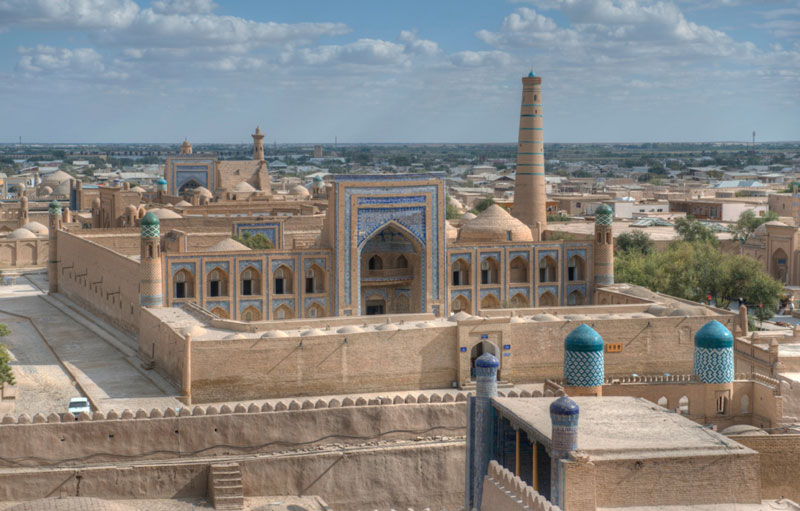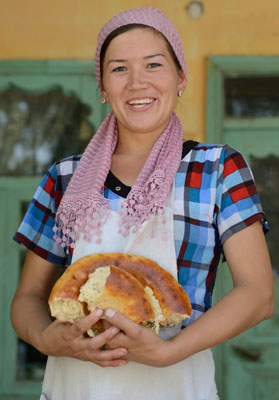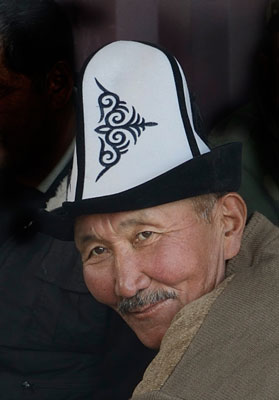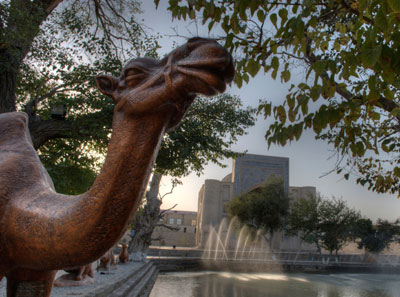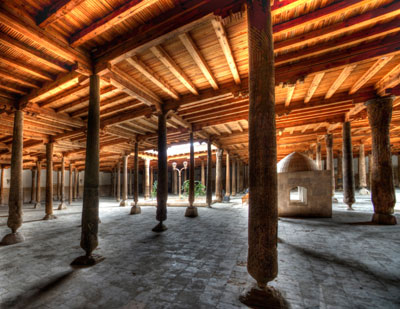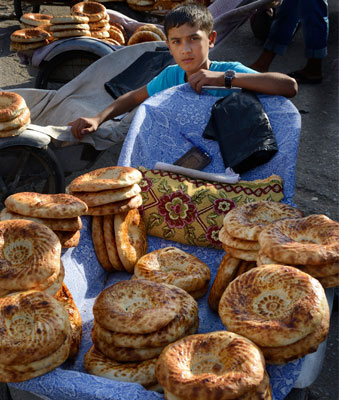A Silk Road journey, 25 years in the making
This article appears on page 6 of the April 2014 issue.
by Stuart Green; Long Beach, CA
On April 26, 1986, Chernobyl’s No. 4 reactor exploded, spewing radioactive material far and wide. My wife and I had prearranged our first Soviet Union trip for June of that year, which included not only St. Petersburg and Moscow but the legendary Silk Road towns of Samarkand, Tashkent and Bukhara. Fearing for our health, we opted out, touring China that summer instead.
Although I didn’t know it at the time, within the following few years I’d make many professional trips to the heartland of Soviet Russia. The Silk Road centers, however, became wistful lines on a lengthy bucket list.
As it turned out, when we finally did get to the newly independent Central Asian Republics, in September-October 2013, we found a far more hospitable and photogenic region than what existed 25 years earlier.
A nation rebuilding
Faded photographs in regional museums illustrate the sorry condition of monuments we would’ve encountered had we traveled to the Silk Road as originally planned.
The great mausoleums, towers, madrassahs (schools), caravansaries and mosques that made the Silk Road cities so glorious 800 years ago had, by the 20th century’s end, been reduced to rubble. The Russian czar’s cannonballs started the destruction in the mid-1800s; Stalin’s policies exacerbated the situation, and, later, locals expropriated bricks and tiles for their homes, barns and outhouses.
During our visit, we learned of the resentment that most Muslims in Central Asia had for the Soviets’ suppression of their faith and the transformation of their holy places into warehouses and stables. We’d previously heard the same lament from Lutherans in Tallinn, Jews in Odessa, Catholics in Vilnius, Buddhists in Ulaanbaatar and Orthodox Christians in St. Petersburg. The Communists were equal-opportunity repressors.
Beginning in 1991, as Central Asian nations gained autonomy after the Soviet Union’s collapse, historians and architects began the painstaking process of restoring the country’s colossal monuments to their once-proud status as the focal points of their major cities.
While purists might contend that reconstruction demeans noble ruins, I believe that the tumbledown appearance of Silk Road buildings during Russian domination was, in reality, a transient illness for which each structure was calling out for recovery.
Restoration proceeds apace. Wherever possible, ancient fabrication techniques seamlessly blend the new with the old. (In rare cases, where the original tile patterns no longer exist, plain tan ceramic facing was used.) As a result, Central Asia has turned into a photographer’s paradise.
Changing times
Many of the region’s peoples, judging by the sentiments of those who spoke to us about the subject, fear Taliban invasion and subsequent repression more than anything else. The magnitude of their apprehension seemed directly proportional to their closeness to adjacent Afghanistan.
Airport and border security personnel appeared particularly wary in the southeastern part of the region. In several places, stern-faced soldiers x-rayed our hand luggage in three successive locations before we got to the ticket counter — and once more thereafter.
Likewise, a centuries-old tradition of Silk Road smuggling has led to entry and exit documents that require detailed cataloging of every valuable: cameras, rings, bracelets, cash and coins. As a warning, our guide told us of travelers who failed to declare their wedding rings on entry forms, only to have them confiscated at departure.
Some Central Asian countries sit atop vast reserves of natural resources that Russia hadn’t fully exploited, as in Turkmenistan, where oil and natural gas have fueled one of history’s most remarkable construction booms.
Ashgabat, the nation’s capital and principal city, bulges with monumental architecture, colossal public buildings and rows of luxurious apartment buildings, all covered with glistening white marble. The city’s highways and byways contain landscaped and fountain-filled lane dividers that seem more suitable to the Land of Oz than a town about 20 miles from the Iranian border.
A few miles outside of Ashgabat, however, donkey carts and camels still transport agricultural products, and the people wear traditional country garb and live in humble abodes — as I said, a photographer’s paradise.
The people
Joseph Stalin created the countries we visited by red-lining on a map various parts of Central Asia into semiautonomous Soviet republics. As a result, mutually unintelligible tribes were suddenly compressed into quasi-nations forced to share Russian as the lingua franca and the Cyrillic alphabet as their sole orthography.
Although quite rusty, my Russian nevertheless proved useful for menu translating, toilet finding and tchotchke bargaining. My most common phrase, however, was “Photo, pozhaluista?”
When planning this journey into ostensibly Muslim lands, we expected to see cities filled with burqa-clad, camera-shy women and finger-wagging, face-turning men. Instead, we found open, friendly people eager to be photographed. Indeed, after we took their pictures, many whipped out camera-phones and asked to have their pictures taken with us! Their smiles lit up with delight upon learning we were Americans.
“The Silk Road,” so named by a 19th-century German geographer, is actually a network of ancient caravan pathways crisscrossing Central Asia. However, the most important product transported along these routes was neither silk nor spices, jade nor jewels. It was religion.
The local inhabitants started out as Animists, as did ancient peoples around the globe. They believed that animals and inanimate objects (trees, mountains, rivers) possessed spirits.
Zoroastrianism arrived with the spreading Persian Empire, while Buddhism swept in from the opposite direction. Greeks, Romans, Nestorian Christians and Hindus all left their marks.
Islamic expansion from Arabia began in the seventh century, pushing other religions out of the area.
The peak of power and influence of Silk Road cities followed the hegemony of Genghis Khan across the region. His claimed descendants, including Babur and Timur the Lame (“Tamerlane”), lorded for centuries over much of Central Asia and, later, the Indian subcontinent.
Today, to establish national identities, regional leaders have elevated these ancient warrior-kings to mythic status, their barbaric, bloodthirsty methods suppressed in lore and legend. (Even Timur’s crippled right leg has somehow been corrected in statues and paintings.)
The architecture
Except for those in Ashgabat, most Silk Road city folk dwelled in monotonously white, Soviet-era apartment blocks, gussied up here and there with pastel balconies or other ornamentation. Shops haven’t yet Moscow-morphed into Gucci or Fendi boutiques.
The main cities are so Soviet cookie-cutter that, but for the restored monuments, our kabob-and-potatoes-fueled adventure wouldn’t have been worth the time or expense. The monuments, however, made the journey meaningful, indeed.
Although, across Central Asia, each ancient complex had its distinct features, varying in scope, scale and grandeur, the general plans were similar: three buildings bordering a wide, square central plaza, on one side a caravanserai, opposite a madrassah, and, in between, a mosque.
The caravanserai served as accommodation for man and beast after a lengthy journey. The madrassah functioned as a school, both secular and religious. Both edifices possessed richly decorated, soaring, arched porticos. The mosques, often with symmetrical domes and one or more minarets, offered solace and spiritual refreshment for the wayfarers.
Today, one, two or all three of these structures are filled with handicraft shops featuring irresistible ceramics, fabrics and paintings. In rare instances, a modern school occupies the madrassah; in some cases, imams have resanctified the mosques.
Not far from the plazas, we found other significant constructs. Depending on the location, it might be a famous saint’s mausoleum, housing for an ancient Koran, a historic astrological observatory or an imposing statue. Beyond that were open markets, where locals picked up their daily bread and victuals.
Samarkand, Uzbekistan, contained the most impressive monumental complex, but each of the other stops along the way had intriguing features as well.
Khiva, an Islamic version of France’s Carcassonne, is a charming, walled Uzbek city that is immensely popular with Europeans. Direct flights from Europe’s capitals daily disgorge smartly dressed visitors looking for a weekend adventure in an exotic yet safe locale.
Planning our trip
Before this trip, our travel brag board was devoid of colored pushpins in Central Asia. Furthermore, none of the Silk Road countries we planned to visit — Kyrgyzstan, Uzbekistan, Kazakhstan, Turkmenistan — existed when Rand McNally published our 1972 map. Instead, we found the words “Kazakh” and “Turkestan” obliquely lettered across the bottom of the Soviet Union’s limitless pink expanse.
We couldn’t even locate on our map some of the cities listed in our brochures and on travel companies’ websites. As with Bombay and Peking, many Central Asian municipalities have reverted to their pre-imperial names.
For this and other reasons, we decided to explore the Silk Road with Travcoa (El Segundo, CA; 888/978-9065), a high-end, California-based company with a reputation for choosing the best-available hotels, super-comfortable buses and the most clear-spoken local guides. In all, 10 people signed up for the 16-day Silk Road journey we chose.
Our fee (approximately $10,000 per person, including internal flights) was all-inclusive and allowed “dine around” meals in local restaurants for which tour members could be reimbursed upon presenting their receipts. However, we had so few free evenings and were so bushed when they did occur, most members of our compatible group dined in hotel restaurants before packing it in for the night.
But, for my wife and me, the situation was a bit different. While in Siberia in the late 1980s, I worked with a number of surgeons from Silk Road cities. Thus, with the exception of our stay in Turkmenistan, our free evenings were spent at gut-busting feasts. The oft-heard invitation “We’ll kill a sheep for you” was, we learned, proffered quite literally, head and all.
Although my wife and I have traveled the world, we were ill-prepared for the many surprises we encountered along our journey.
With 12-hour bus rides, small-minded border bureaucrats and the relentless equation of intercity air travel (a 7 a.m. flight = a 4:30 a.m. wake-up call) resulting in a fatiguing journey, this is not a trip for first-time travelers. Having said that, the gorgeous photo ops, the astounding monuments and the warm and friendly people made for a most memorable expedition for all of us.

